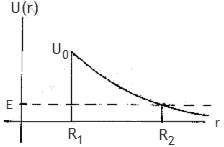This is a "square potential" problem. We solve HΦ(x) = EΦ(x) in regions where U(x) is constant and apply boundary conditions.
We are given a piecewise constant potential. We are asked to find the transmittance T.
(a) Divide space into 3 regions;
region 1: x < 0, region 2: 0 < x < a, region 3: x > a.
(a) potential barrier, E < U0.
The most general solutions in regions 1, 2, and 3 are
Φ1(x) = A1exp(ikx) + A1'exp(-ikx),
Φ2(x) = B2exp(ρx) + B2'exp(-ρx),
Φ3(x) = A3exp(ikx).
Here k2 = (2m/ħ2)E and ρ2 = (2m/ħ2)(U0 - E).
The boundary conditions are that Φ(x) and (∂/∂x)Φ(x) are continuous at x = 0 and x = a.
x = 0: A1 + A1' = B2 + B2', ikA1 - ikA1' = ρB2 - ρB2'.
x = a: B2exp(ρa) + B2'exp(-ρa) = A3exp(ika),
ρB2exp(ik2a) - ρB2'exp(-ρa) = ikiA3exp(ika).
We need to solve these equations for A3 and A1' in terms of A1.
(i) Solve for B2 and B2' in terms of A3.
B2 = ½exp((ik - ρ)a)(1 + ik/ρ )A3 = C A3.
B2' = ½exp((ik + ρ)a)(1 - ik/ρ)A3 = C' A3.
(ii) Now solve for A1 in terms of A3 to find T.
2A1 = B2 + B2' + (ρ/ik)(B2 - B2') = (C + C' + (ρ/ik) (C - C'))A3.
A1 = ([(k2 - ρ2)/(2ikρ)]sinhρa + coshρa)exp(ika)A3.
T = |A3/A1|2 = 4k2ρ2/[(k2 - ρ2)2sinh2ρa + 4k2ρ2cosh2ρa]
= 4k2ρ2/[(k2 + ρ2)2sinh2ρa + 4k2ρ2].
[cosh2x - sinh2x = 1.]
T = 4E(U0 - E)/[U02sinh2[(2m(U0 - E)/ħ2)1/2a] + 4E(U0 - E)].
(b) E << U0 and 2mU0a2/ħ2
>> 1.
sinh(x) = ½(ex - e-x) ≈ ½ex, if x >> 1.
Therefore
T ≈ 4E(U0 - E)/[¼U02exp[2(2m(U0
- E)/ħ2)1/2a] + 4E(U0 - E)]
≈ 4EU0/[¼U02exp[2(2mU0/ħ2)1/2a] + 4EU0)]
≈ (16E/U0)exp[-2(2mU0/ħ2)1/2a].
(c) Assume that
T ≈ exp[-2∫R1R2 dr (2m(U(r) - E)/ħ2)1/2].

R1 = R0, R2 = U0R0/E,
R2 >> R1.
∫R1R2 dr (U(r) - E)1/2 = ∫R1R2 dr (U0R0/r
- U0R0/R2)1/2
= (U0R0)1/2∫R1R2 dr (1/r
- 1/R2)1/2.
∫R1R2 dr (1/r - 1/R2)1/2 = ∫R1R2 dr
[(R2 - r)/(rR2)]1/2
= √R2[(R1/R2 - (R1/R2)2)1/2
+ π/2 - tan-1(R1/(R2 - R1))1/2
--> √R2 π/2 if R2 >> R1.
T ≈ exp[-√(2m/E) πU0R0/ħ) = e-λ', λ' =
√(2m/E) πU0R0/ħ
e-λ' is the transmission coefficient.
To calculate the escape probability per second, we have to multiply T by the
rate of the alpha particle hitting the barrier, which is approximately v/R0.
escape probability ≈ √(2m/E)/R0 * e-λ' = λ =
1/τ.
This is a reasonable order of magnitude approximation as long as the escape
probability is very small.